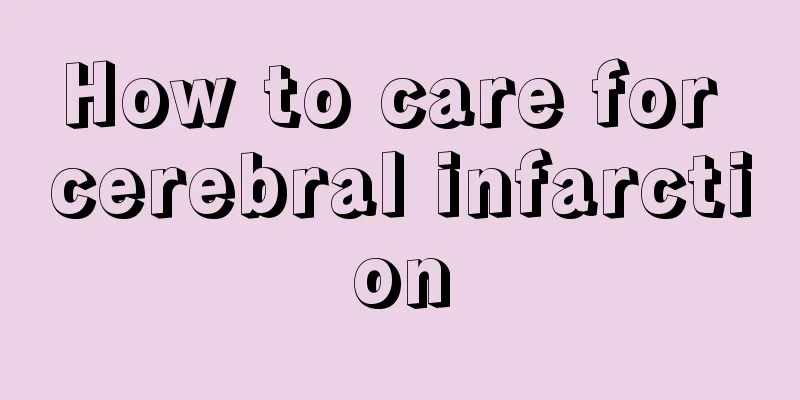What are the nursing methods for patients with cerebral hemorrhage?

|
Cerebral hemorrhage, also known as cerebral hemorrhage, is a vascular disease of the human brain. It is very harmful to human health and can easily endanger the patient's life. Cerebral hemorrhage requires timely treatment, and care is more important during treatment. Generally, patients with cerebral hemorrhage need to stay in bed for more time, and the head should not move back and forth. It can be turned appropriately to avoid bleeding again. Cerebral hemorrhage care 1. After the rescue of cerebral hemorrhage, the patient must rest in bed for 2 weeks. The head can be gently turned left and right, but cannot be raised. The limbs should move slightly every 2 hours to improve blood circulation. The patient cannot get out of bed to urinate or defecate on his own to avoid another cerebral hemorrhage. 2. The main cause of cerebral hemorrhage is high blood pressure and arteriosclerosis caused by high blood pressure. Therefore, you must strictly follow the doctor's instructions to take antihypertensive drugs on time and in the right amount to prevent blood pressure fluctuations from aggravating the condition. 3. Patients with cerebral hemorrhage need a quiet and comfortable rest environment, so within 2 weeks of onset, it is best to visit the patient less often. This will allow the patient to maintain a stable and calm mood and avoid re-bleeding. 4. Patients will experience headaches during the course of cerebral hemorrhage. The pain varies from person to person and may manifest as swelling, tingling, severe pain, etc. Headache is the most common symptom in the early stages of cerebral hemorrhage. Don't be nervous. You can massage the patient's head appropriately to relieve the pain. 5. Bed sores are prone to occur due to long-term bed rest, so patients with cerebral hemorrhage should be given more massages on the pressure points and their skin should be kept dry and clean. Especially for the elderly, long-term bed rest is prone to lung infection, so they should be turned over and patted on the back more often to help them cough up phlegm. 6. Reasonable dietary conditioning can help cure cerebral hemorrhage. When caring for patients with cerebral hemorrhage, you can give them natural anticoagulant and passive lipid foods, foods rich in arginine and other kidney-tonifying and essence-replenishing foods, and foods rich in folic acid. Pay attention to eating small meals frequently, eat more fresh fruits and vegetables, and drink more boiled water. Causes Common causes are hypertension combined with arteriosclerosis, microaneurysms or microvascular aneurysms. Others include cerebral vascular malformations, meningeal arteriovenous malformations, amyloid angiopathy, cystic hemangiomas, intracranial venous thrombosis, specific arteritis, fungal arteritis, moyamoya disease and arterial anatomical variations, vasculitis, and tumor stroke. In addition, blood factors include anticoagulation, antiplatelet or thrombolytic therapy, Haemophilus infection, leukemia, thrombotic thrombocytopenia, intracranial tumors, alcohol poisoning and sympathetic nerve stimulant drugs. The triggering factors include overexertion, climate change, bad habits (smoking, alcoholism, excessive salt intake, being overweight), blood pressure fluctuations, emotional excitement, and excessive fatigue. Clinical manifestations Hypertensive cerebral hemorrhage often occurs in people aged 50 to 70 years old, slightly more often in men. It is more likely to occur in winter and spring, usually during activities and emotional excitement. There are usually no warning signs before bleeding. Half of the patients have severe headaches and vomiting is common. Blood pressure rises significantly after bleeding. Clinical symptoms often reach a peak within minutes to hours. Clinical symptoms and signs vary depending on the site and amount of bleeding. Mild hemiplegia caused by bleeding in the basal ganglia, thalamus and internal capsule is a common early symptom. A small number of cases have epileptic seizures, which are often focal. Severe cases quickly turn into confusion or coma. 1. Movement and language disorders The most common movement disorder is hemiplegia; the most common speech disorder is aphasia and slurred speech. 2. Vomiting About half of the patients experience vomiting, which may be related to increased intracranial pressure, vertigo, and irritation of the meninges by blood during cerebral hemorrhage. 3. Impairment of consciousness It manifests as drowsiness or coma, the degree of which is related to the location, amount and speed of cerebral hemorrhage. Large amounts of bleeding in deep parts of the brain within a short period of time will most likely result in impaired consciousness. 4. Eye symptoms Anisocoria often occurs in patients with increased intracranial pressure and brain herniation; there may also be hemianopsia and eye movement disorders. During the acute phase of cerebral hemorrhage, patients often stare at the bleeding side of the brain (gaze paralysis). 5. Headache and dizziness Headache is the first symptom of cerebral hemorrhage, often located on the side of the head with bleeding; when there is increased intracranial pressure, the pain can spread to the entire head. Dizziness often accompanies headache, especially when bleeding occurs in the cerebellum or brain stem. |
<<: Is it necessary to store the mask in the refrigerator?
>>: What nursing measures should be taken for burn patients?
Recommend
What is colitis? Early symptoms to know
The most typical symptom of colitis in the early ...
What is the reason for anal odor
If the anus smells and is accompanied by a damp f...
What are the main factors that induce nasopharyngeal carcinoma?
The occurrence of nasopharyngeal cancer is quite ...
Treatment of sequelae of scoliosis surgery
In daily life, we all know the harm that scoliosi...
Can people with teratoma participate in sports?
Teratoma has become a disease that endangers wome...
What dishes are easy to digest and good for the stomach
Nowadays, people are generally under great pressu...
The fastest way to promote blood circulation and relieve blood stasis
Many people in our lives often suffer from trauma...
What tea should I drink for bloating?
In daily life, we all know that if we eat too muc...
What are the benefits of drinking American ginseng in water for women
American ginseng is a very familiar Chinese medic...
What are the effects and contraindications of jasmine tea?
Jasmine tea is very famous among scented teas, an...
Is renal hamartoma dangerous? Can it be cured? How long can one live?
Renal hamartomas are generally benign tumors with...
Two-month-old baby's poop has blood streaks, sometimes good and sometimes bad
We all know that for two-month-old babies, their ...
Why are my ears red and itchy
In life, we always encounter various small proble...
Seven methods to clear stool without delay
Modern people lead busy and stressful lives, and ...
Ginger removes acne marks, teach you 3 tips
The most annoying thing for us is the many pimple...









